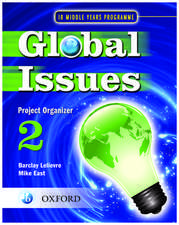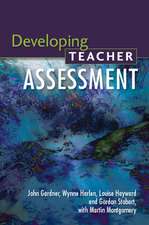How to Assess Authentic Learning
Autor Kathleen B. Burkeen Limba Engleză Paperback – 28 dec 2009
For many years, assessment was relegated to a secondary role in the educational process. But with the increased emphasis on high-stakes testing, effective assessment has emerged as one of the major factors in raising student achievement.
In this latest edition of her bestseller, renowned educator Kay Burke provides a wide range of updated, easy-to-implement alternative assessments that address today's accountability requirements and focus on improving learning. Designed for use across all content areas, these formative assessments are rooted in the language of state standards and emphasize differentiating instruction to meet students' individual learning needs. Revised throughout with updated research, this new edition helps teachers:
- Build Response to Intervention checklists for struggling students
- Develop unit plans using differentiated learning and assessment strategies
- Create portfolios that emphasize metacognition
- Design performance tasks that motivate and engage students
- Construct rubrics that describe indicators of quality work
- Create tests that focus on higher-order thinking skills
Offering numerous applications and examples, How to Assess Authentic Learning guides teachers in developing the assessment tools needed to help all students meet or exceed mandated academic standards.
Preț: 298.20 lei
Nou
Puncte Express: 447
Preț estimativ în valută:
57.06€ • 59.74$ • 47.21£
57.06€ • 59.74$ • 47.21£
Carte disponibilă
Livrare economică 17-31 martie
Livrare express 28 februarie-06 martie pentru 39.45 lei
Preluare comenzi: 021 569.72.76
Specificații
ISBN-13: 9781412962797
ISBN-10: 141296279X
Pagini: 232
Dimensiuni: 216 x 279 x 14 mm
Greutate: 0.63 kg
Ediția:Fifth Edition
Editura: SAGE Publications
Colecția Corwin
Locul publicării:Thousand Oaks, United States
ISBN-10: 141296279X
Pagini: 232
Dimensiuni: 216 x 279 x 14 mm
Greutate: 0.63 kg
Ediția:Fifth Edition
Editura: SAGE Publications
Colecția Corwin
Locul publicării:Thousand Oaks, United States
Recenzii
"Burke
has
challenged
teachers
everywhere
to
raise
their
standards
and
design
classroom
assessments
that
show
evidence
of
understanding
and
performance
on
complex
tasks.
The
expert
examples
in
this
book
provide
teachers
a
complete
road
map
so
that
assessment
is
truly
at
the
heart
of
instruction."
"An important text. Classroom teachers will find the descriptions and examples very doable and extremely helpful."
"This book will certainly appeal to educators across the nation. The abundance of research and examples will certainly benefit and motivate teachers and administrators."
"This is the type of text that teachers will keep so that they can reference it in the future."
"There is a great deal of practical, useful information that teachers will find valuable."
"A powerful tool with classroom-ready examples that demonstrate sound and valuable assessment practices. It’s a phenomenal resource."
“Wow! Burke has written a book for schools that really gets to the point! It is easy to use and rich in resources such as checklists, rubrics, and sample unit designs to help every principal be an effective learning leader and allow teachers to utilize an approach rich in best practices for balanced assessment.”
"An important text. Classroom teachers will find the descriptions and examples very doable and extremely helpful."
"This book will certainly appeal to educators across the nation. The abundance of research and examples will certainly benefit and motivate teachers and administrators."
"This is the type of text that teachers will keep so that they can reference it in the future."
"There is a great deal of practical, useful information that teachers will find valuable."
"A powerful tool with classroom-ready examples that demonstrate sound and valuable assessment practices. It’s a phenomenal resource."
“Wow! Burke has written a book for schools that really gets to the point! It is easy to use and rich in resources such as checklists, rubrics, and sample unit designs to help every principal be an effective learning leader and allow teachers to utilize an approach rich in best practices for balanced assessment.”
Cuprins
Acknowledgments
About the Author
Introduction
Standardized Tests and Classroom Assessments
Assessment Literacy
Accountability
Grading
Traditional Cognitive Science
Assessment and Evaluation
Definitions of Performance Assessment
Portfolios
Balanced Assessment
And Now...the Tools!
1. Student Learning Standards
What Are Learning Standards and Benchmarks?
What Is the Standards Movement?
How Did the Standards Movement Begin?
What Are Preformance Standards?
Why Do We Need Standards?
How Can We Use Standards?
Final Thoughts
2. Differentiated Learning
What Is Differentiated Learning?
What Are the Multiple Intelligences?
Why Should We Use Differentiation?
How Should We Use the Multiple intelligences?
Final Thoughts
3. Student Portfolios
What is a Portfolio?
Why Should We Use Portfolios?
How Can We Implement Portfolios?
Final Thoughts
4. Performance Tasks and Rubrics
What Are Performance Tasks?
Why Should We Use Performance Tasks?
How Should We Create Performance Tasks?
How Should We Assess Performance Tasks?
Final Thoughts
5. Checklists and Rubrics
What Are Checklists?
Why Should We Use Checklists?
How Should We Use Checklists?
What Are Rubrics?
How Should We Use Rubrics?
How Can Rubrics Be Used?
What is the Checklist-Rubrics Connection?
How Do We Create Assessments?
Final Thoughts
6. Metacognition
What Is Metacognitive Reflection?
Why Should We Use Megacognitive Reflection?
How Should We Use Megacognitive Reflection?
What Are Learning Logs and Journals?
Why Should We Use Learning Logs and Journals?
How Should We Use Learning Logs and Journals?
How Should We Assess Learning Logs and Journals??
Finals Thoughts
7. Graphic Organizers
What Are Graphic Organizers?
Why Should We Use Graphic Organizers?
How Should Graphic Organizers Be Used For Assessment?
Final Thoughts
8. Teacher-Made Tests
What Are Teacher-Made Tests?
Why Do We Need Teacher-Made Tests?
How Can We Design Better Teacher-Made Tests?
Final Thoughts
9. Interviews and Conferences
What Are Interviews and Conferences?
Why Should We Use Interviews and Conferences?
How Should We Assess Interviews and Conferences?
Final Thoughts
Conclusion
Resources: Performance Task Units
Resource A: Investigating Rocks, Minerals, and Soils in Third-Grade Science
Resource B: A Middle School Economics Performance Task
Resource C: Using Algebra to Plan a Garden Party
Resource D: Foreign Language Performance Task for Middle and High School
Resource E: Thinking About Themes Through texts and Tasks in Literature, Grades 9-12
References
Index
About the Author
Introduction
Standardized Tests and Classroom Assessments
Assessment Literacy
Accountability
Grading
Traditional Cognitive Science
Assessment and Evaluation
Definitions of Performance Assessment
Portfolios
Balanced Assessment
And Now...the Tools!
1. Student Learning Standards
What Are Learning Standards and Benchmarks?
What Is the Standards Movement?
How Did the Standards Movement Begin?
What Are Preformance Standards?
Why Do We Need Standards?
How Can We Use Standards?
Final Thoughts
2. Differentiated Learning
What Is Differentiated Learning?
What Are the Multiple Intelligences?
Why Should We Use Differentiation?
How Should We Use the Multiple intelligences?
Final Thoughts
3. Student Portfolios
What is a Portfolio?
Why Should We Use Portfolios?
How Can We Implement Portfolios?
Final Thoughts
4. Performance Tasks and Rubrics
What Are Performance Tasks?
Why Should We Use Performance Tasks?
How Should We Create Performance Tasks?
How Should We Assess Performance Tasks?
Final Thoughts
5. Checklists and Rubrics
What Are Checklists?
Why Should We Use Checklists?
How Should We Use Checklists?
What Are Rubrics?
How Should We Use Rubrics?
How Can Rubrics Be Used?
What is the Checklist-Rubrics Connection?
How Do We Create Assessments?
Final Thoughts
6. Metacognition
What Is Metacognitive Reflection?
Why Should We Use Megacognitive Reflection?
How Should We Use Megacognitive Reflection?
What Are Learning Logs and Journals?
Why Should We Use Learning Logs and Journals?
How Should We Use Learning Logs and Journals?
How Should We Assess Learning Logs and Journals??
Finals Thoughts
7. Graphic Organizers
What Are Graphic Organizers?
Why Should We Use Graphic Organizers?
How Should Graphic Organizers Be Used For Assessment?
Final Thoughts
8. Teacher-Made Tests
What Are Teacher-Made Tests?
Why Do We Need Teacher-Made Tests?
How Can We Design Better Teacher-Made Tests?
Final Thoughts
9. Interviews and Conferences
What Are Interviews and Conferences?
Why Should We Use Interviews and Conferences?
How Should We Assess Interviews and Conferences?
Final Thoughts
Conclusion
Resources: Performance Task Units
Resource A: Investigating Rocks, Minerals, and Soils in Third-Grade Science
Resource B: A Middle School Economics Performance Task
Resource C: Using Algebra to Plan a Garden Party
Resource D: Foreign Language Performance Task for Middle and High School
Resource E: Thinking About Themes Through texts and Tasks in Literature, Grades 9-12
References
Index
Descriere
This
updated
edition
helps
primary
and
secondary
teachers
build
observation
checklists,
develop
unit
plans,
and
design
performance
tasks
and
rubrics
that
address
mandated
academic
standards.










